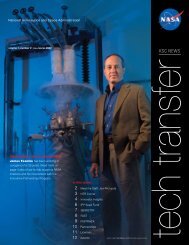2006-2007 - Kennedy Space Center Technology Transfer Office
2006-2007 - Kennedy Space Center Technology Transfer Office
2006-2007 - Kennedy Space Center Technology Transfer Office
- No tags were found...
You also want an ePaper? Increase the reach of your titles
YUMPU automatically turns print PDFs into web optimized ePapers that Google loves.
Figure 2. Three-dimensional simulation geometry with varying cratersizes at equal distances from the rocket blast center.Figure 3. Trajectory plots of 90-µm lunar dust particles initialized to varying distancesfrom the rocket blast center.conditions, the simulation results for various particle sizes and trajectory angles are adjusted ad hoc to match Apollovideo photogrammetry.The gas properties, density, velocity vector, and temperature predicted by the CFD/DSMC simulations allow us tocompute the forces on a single particle of regolith. Once these forces are known, the trajectory path and velocity ofthe particle are computed. Note that all calculations of trajectory assume that the duration of particle flight is muchshorter than the change in gas properties. In other words, the particle trajectory calculations take into account thespatial variation of the gas jet, but not the temporal variation. This is a reasonable first-order assumption.Contact: Dr. Philip T. Metzger , NASA-KSC, (321) 867-6052Participating Organization: ASRC Aerospace (Dr. Christopher D. Immer and Dr. John E. Lane)KSC <strong>Technology</strong> Development and Application <strong>2006</strong>-<strong>2007</strong>43













